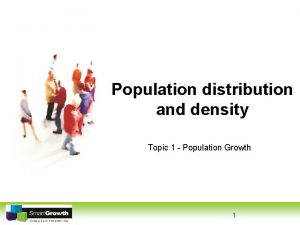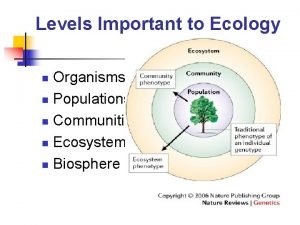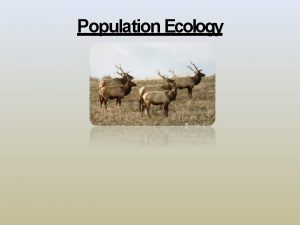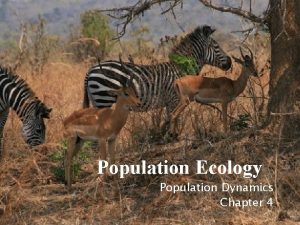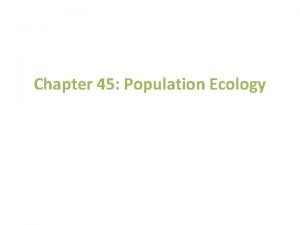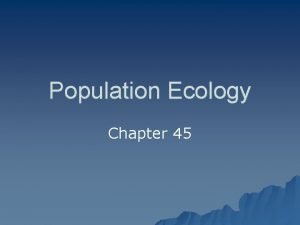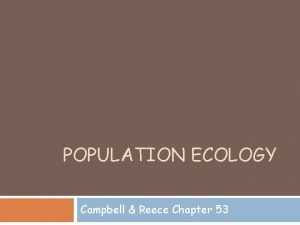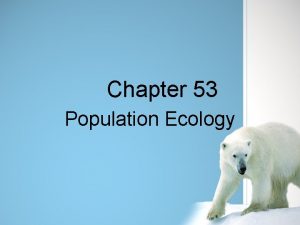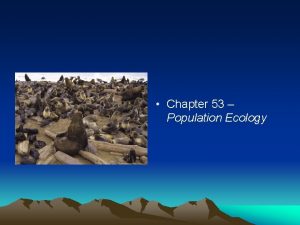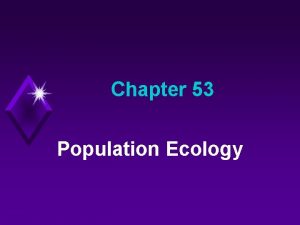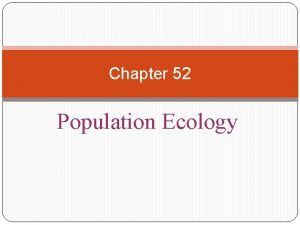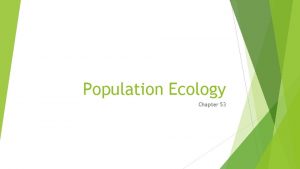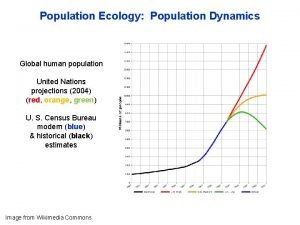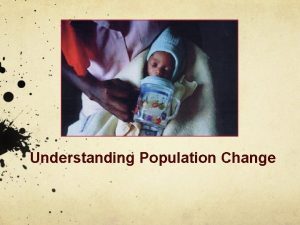Population Ecology Chapter 39 Ecology Definition The science

































- Slides: 33

Population Ecology Chapter 39

Ecology - Definition • The science of the relationships between organisms and their environments. or • The interactions that organisms have with other organisms and with their environment.

Population • A group of individuals of the same species occupying a given area • Can be described by demographics – Vital statistics such as size, density, distribution, and age structure

Population Age Structure • Divide population into age categories – Pre-reproductive – Reproductive – Post-reproductive • Population’s reproductive base includes members of the reproductive and prereproductive age categories

Density & Distribution • Number of individuals in some specified area of habitat • Crude density information is more useful if combined with distribution data clumped nearly uniform random

Determining Population Size • Direct counts are most accurate but seldom feasible • Can sample an area, then extrapolate • Capture-recapture method is used for mobile species

Capture-Recapture Method • Capture, mark, and release individuals • Return later and capture second sample • Count the number of marked individuals and use this to estimate total population

Assumptions in Capture-Recapture • Marking has no effect on mortality • Marking has no effect on likelihood to being captured • There is no immigration or emigration between sampling times

Changes in Population Size • Immigration adds individuals • Emigration subtracts individuals • Births add individuals • Deaths subtract individuals

Zero Population Growth • Interval in which number of births is balanced by number of deaths • Assume no change as a result of migration • Population size remains

Exponential Growth • Population size expands by ever increasing increments during successive intervals • The larger the population gets, the more individuals there are to reproduce

Biotic Potential • Maximum rate of increase per individual under ideal conditions • Varies between species • In nature, biotic potential is rarely reached

Limiting Factors • Any essential resource that is in short supply • All limiting factors acting on a population dictate sustainable population size

Carrying Capacity (K) • Maximum number of individuals that can be sustained in a particular habitat • Logistic growth occurs when population size is limited by carrying capacity

Logistic Growth • As size of the population increases, rate of reproduction decreases • When the population reaches carrying capacity, population growth ceases

Density-Dependent Controls • Logistic growth equation deals with density-dependent controls • Limiting factors become more intense as population size increases • Disease, competition, parasites, toxic effects of waste products

Density-Independent Controls • Factors unaffected by population density • Natural disasters or climate changes affect large and small populations alike

Human Population Growth • Population now exceeds 6 billion • Rates of increase vary among countries • Average annual increase is 1. 26 percent • Population continues to increase exponentially

Side-Stepping Controls • Expanded into new habitats • Agriculture increased carrying capacity; use of fossil fuels aided increase • Hygiene and medicine lessened effects of density-dependent controls

Future Growth • Exponential growth cannot continue forever • Breakthroughs in technology may further increase carrying capacity • Eventually, density-dependent factors will slow growth

Population Growth Curve Estimated size by 10, 000 years ago 5 million By 1804 1 billion By 1927 2 billion By 1960 3 billion By 1974 4 billion By 1987 5 billion By 1999 6 billion Projected for 2050 8. 9 billion Human Population Growth

Fertility Rates • Total fertility rate (TFR) is average number of children born to a woman • Highest in developing countries, lowest in developed countries

Fertility Rates Compared U. S. – brown bar Brazil – red bar Nigeria – gold bar

Age Structure Diagrams • Show age distribution of a population

Age Structure Diagrams: 1997

Population Momentum • Lowering fertility rates cannot immediately slow population growth rate • Why? There already many future parents alive • If every couple had just two children, population would still keep growing for another 60 years

Slowing Growth in China • World’s most extensive family planning program • Government rewards small family size, penalizes larger families, provides free birth control, abortion, sterilization • Since 1972, TFR down to 1. 8 from 5. 7

Effects of Economic Development • Total fertility rates (TFRs) are highest in developing countries, lowest in developed countries • When individuals are economically secure, they are under less pressure to have large families

Demographic Transition Model • Based on historical data from western Europe • Postulates that as countries become industrialized, first death rates drop, then birth rates drop

Demographic Transition Model Stage 1 Preindustrial Stage 2 Transitional Stage 3 Industrial Stage 4 Postindustrial relative population size births deaths low increasing very high decreasing low zero negative

Immigration

Resource Consumption • United States has 4. 6 percent of the world’s population • Americans have a disproportionately large effect on the world’s resources • Per capita, Americans consume more resources and create more pollution than citizens of less developed nations, or any other country by far!

Projecting Human Population Size
 Chapter 4 section 1 population dynamics answer key
Chapter 4 section 1 population dynamics answer key Chapter 4 section 1 population dynamics
Chapter 4 section 1 population dynamics Population ecology section 1 population dynamics answer key
Population ecology section 1 population dynamics answer key Population ecology section 1 population dynamics
Population ecology section 1 population dynamics Chapter 53 population ecology
Chapter 53 population ecology Chapter 36 population ecology
Chapter 36 population ecology Chapter 4 population ecology answer key
Chapter 4 population ecology answer key Chapter 53 population ecology
Chapter 53 population ecology Chapter 4 section 1 population dynamics
Chapter 4 section 1 population dynamics Chapter 53 population ecology
Chapter 53 population ecology Population definition ecology
Population definition ecology Clumped dispersion
Clumped dispersion Exponential population growth
Exponential population growth Fig 52
Fig 52 Population vs community ecology
Population vs community ecology Concept 3 population ecology
Concept 3 population ecology Survivorship curve def
Survivorship curve def Characteristic of population
Characteristic of population Population characteristics ecology
Population characteristics ecology Ideal population growth curve
Ideal population growth curve Population distribution
Population distribution Parasitism
Parasitism My favorite subject is art because
My favorite subject is art because Ecology is a science which studies the relationship between
Ecology is a science which studies the relationship between Ecology and environmental science difference
Ecology and environmental science difference Hát kết hợp bộ gõ cơ thể
Hát kết hợp bộ gõ cơ thể Ng-html
Ng-html Bổ thể
Bổ thể Tỉ lệ cơ thể trẻ em
Tỉ lệ cơ thể trẻ em Gấu đi như thế nào
Gấu đi như thế nào Chụp phim tư thế worms-breton
Chụp phim tư thế worms-breton Bài hát chúa yêu trần thế alleluia
Bài hát chúa yêu trần thế alleluia Môn thể thao bắt đầu bằng từ đua
Môn thể thao bắt đầu bằng từ đua Thế nào là hệ số cao nhất
Thế nào là hệ số cao nhất




















